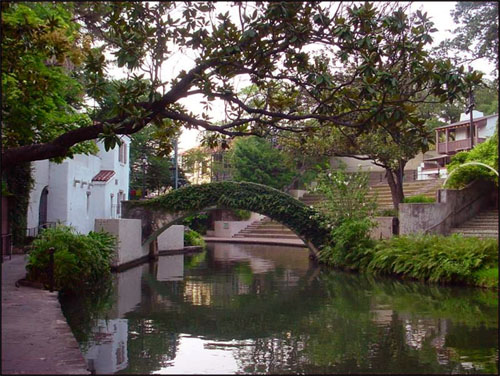Apr 13, 2025
Apr 13, 2025
Attreyee Roy Chowdhury walks along the horseshoe loop of the San Antonio river, discovering, as she goes along, the history of this old Spanish town in Texas.
San Antonio’s old Spanish flavor, multi-cultural citizenry and many parks and plazas make it one of America’s more picturesque cities. Modern skyscrapers co-exist harmoniously with the 18th century restorations. Since most of downtown was built before 1930, the architectural mix is as varied as the periods and materials allowed. Alamo style rooflines blend with sea-shell ornamented commercial buildings and cream-colored stucco structures with red-tiled roofs.

It is not the architecture that is the soul of the city, but the San Antonio river, which makes a 15-mile horseshoe loop through six miles of downtown. The river symbolizes the beauty and romance of the city. While sampling its waters is no longer recommended, visitors will be drawn back to the Riverwalk or Paseo del Rio, a tree-lined footpath, romantically lighted at night, that follows the riverbanks which are landscaped with lush subtropical foliage and bordered by nightspots, restaurants and shops.
A popular T-shirt slogan sums it up: ‘San Antonio: A River Walks Through It’. Not run, but walks. The San Antonio River doesn’t roll, it strolls. And so do visitors down the two-and-a-half mile Riverwalk, everybody’s favorite place to browse, graze and gaze.
With its hospitable combination of restaurants, shops, bars and hotels, the Riverwalk is the city’s biggest tourist attraction. But it’s not only a visitors’ venue, locals lunch here too, or stop off after work at one of the river’s many watering holes.
The Riverwalk’s unique stone walkways, bridges and stairways were constructed between 1939 and 1941 – a new deal for the city aided by a grant from a New Deal agency, the Works Progress Administration. The exotic tropical landscaping was added later, and most commercial development came later still.
Today, the Riverwalk is a bi-level festival place, bisected by a lazy river, green as lime Jell-o, tranquil as a bathtub. Still, its banks bustle all summer long. There’s world of activity here, a dozen feet below street level.
On the riverwalk you will find hill country peach potpourri, armadillo puppets, beeswax candles, Mexican folk art and African clothing. The shops cater to every taste: antiques or contemporary crafts, premium ice-cream or hot jalapeno jelly.
Prowling the river for the perfect lunch spot is not an easy task. There are more than 50 restaurants. All of them post their menus outside and many employ enthusiastic employees to pull in customers.
Nearby stands the Arnesan River Theatre, an outdoor amphitheatre with grassy seats notched in the river bank. During the summer, local song-and-dance groups such as Fiesta Flamenco, Fandango Troupe and Fiesta Noche del Rio share the stage in rotation: evening shows are costumed spectacles with a south-of-the-border accent.
Entertainment – of all kinds – is integral to the Riverwalk. There’s the Rivercenter Comedy Club, a year-old nightspot that has played host to such humor heavyweights of USA like Rich Hall of Saturday Night Live and George Miller, frequent guest on Late Night with David Letterman.
The Riverwalk is really an example of a successful urban renewal project. Once lined with ramshackle houses, this peaceful river was named after St Anthony de Padua on June 13, 1691, when the Spaniards first came upon the river and its Indian camps. Between 1718 and 1731, five missions and a village were founded along its banks. Today, San Antonio is USA’s ninth largest city.
You can find evidence of every event in the history of the place in this horseshoe-shaped bend in the heart of the city. Etched here are the stormy moments – the Indian raids, the “storming of Bexar in 1835”, the Battle of Alamo in 1836 and the floods in 1921 and 1929.
And the triumphs – like the victory of the conservationists who saved this historic bend when flood control measures threatened to remove it in the 1920s.
The town has a 250-year old history, and that history flows with the river.
First published in ‘The Independent’ newspaper (Mumbai) in 1994
Image courtesy: http://www.trinity.edu/
19-Nov-2006
More by : Attreyee Roy Chowdhury